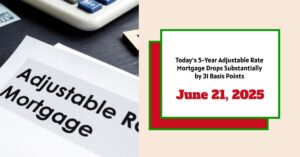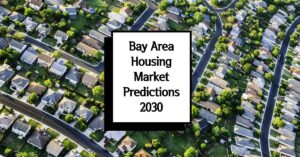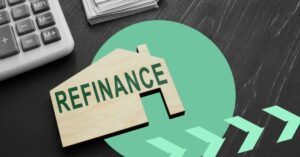As of June 22, 2025, mortgage rates have slightly dropped, with the national average 30-year fixed mortgage rate at 6.88%, down from 6.89% last week, as reported by Zillow. This downward trend can also be seen in the average 15-year fixed mortgage rate, which decreased to 5.91% from 5.92%. These changes signify a modest yet significant moment for potential homebuyers and those looking to refinance their existing loans.
Mortgage Rates Today – June 22, 2025: Rates Drop Marginally Across the Board
Key Takeaways
- Current average 30-year mortgage rate: 6.88%
- Current average 15-year mortgage rate: 5.91%
- Refinance rates for 30-year fixed loans: 7.20%
- Rates are slightly down compared to last week for most loan types
Current Mortgage Rates Overview
Understanding today’s mortgage rates is crucial for both homebuyers and those looking to refinance an existing loan. On June 22, 2025, data depict that mortgage rates are experiencing a mild decrease, which could benefit those seeking new loans or considering refinancing their current terms. The following tables summarize the current mortgage rates for various loan types.
Mortgage Rates by Loan Type
| Loan Type | Current Rate | 1-Week Change | APR | 1-Week Change |
|---|---|---|---|---|
| 30-Year Fixed | 6.88% | down 0.05% | 7.36% | down 0.03% |
| 20-Year Fixed | 6.20% | down 0.30% | 6.68% | down 0.22% |
| 15-Year Fixed | 5.91% | down 0.10% | 6.23% | down 0.08% |
| 10-Year Fixed | 6.01% | up 0.01% | 6.10% | down 0.17% |
| 7-Year ARM | 7.36% | up 0.03% | 7.83% | down 0.09% |
| 5-Year ARM | 6.99% | down 0.35% | 7.73% | down 0.13% |
| 3-Year ARM | — | 0.00% | — | 0.00% |
Refinance Rates by Loan Type
| Loan Type | Current Rate | 1-Week Change | APR | 1-Week Change |
|---|---|---|---|---|
| 30-Year Fixed Refi | 7.20% | up 0.04% | 7.36% | down 0.03% |
| 15-Year Fixed Refi | 6.06% | up 0.04% | 6.23% | down 0.08% |
| 5-Year ARM Refi | 7.50% | unchanged | — | — |
Source: Zillow
Trends in Mortgage Rates
Over the preceding weeks leading up to June 22, 2025, there has been a noticeable trend of decreasing mortgage rates. This decline poses an advantageous opportunity for potential homebuyers. Specifically, the 30-year fixed mortgage rates have decreased by 5 basis points this week alone from a previous average of 6.93%, indicating a positive shift in borrowing costs for consumers. This is particularly encouraging for first-time homebuyers who may have found the higher rates of the past couple of years daunting.
Conversely, for those interested in refinancing, the current national average for 30-year fixed refinance loans is 7.20%, which shows a slight increase from the previous week’s rate of 7.16%. The fluctuation in refinance rates reflects broader economic factors, including changes in the Federal Reserve's monetary policy and market demands.
Refinancing Options in Today’s Market
Refinancing remains a viable option for homeowners looking to either lower their monthly payments or tap into their home equity. Mortgage rates for refinance options include both fixed and adjustable-rate mortgages (ARMs).
- Fixed-rate loans provide stability in monthly payments, ideal for those looking for predictability over a long term. For example, if you currently have a mortgage at a higher interest rate, refinancing to a lower fixed rate can save you hundreds of dollars each month. This stability can be particularly useful during times of economic uncertainty.
- Adjustable-rate mortgages (ARMs) can initially offer lower rates compared to fixed options, but they carry a risk as rates can change over time. For instance, a homebuyer who secures a 5-year ARM might benefit from a lower initial payment, but if interest rates rise after the initial period, their payments could significantly increase.
According to a report by the Mortgage Bankers Association, rates are projected to remain around 6.8% through September, before trending slightly lower by year-end. This ongoing variability presents a particularly appealing scenario for those looking to refinance, as even a small drop in rates could result in major savings over the life of a loan.
Fannie Mae and Long-Term Forecasts
The long-term outlook for mortgage rates remains cautiously optimistic, with projections from Fannie Mae estimating rates to fall to 6.1% by the end of 2025, and further to 5.8% in 2026. These predictions should excite potential buyers, as lower rates can lead to cheaper mortgage payments. The Federal Reserve's ongoing efforts to combat inflation have led to frequent adjustments in interest rates, but the overall forecast suggests a more stable environment for borrowers.
Fannie Mae's updated forecast for home sales has also been revised to 4.92 million, indicating a healthy demand for housing despite economic uncertainties. The continued rise in home sales could lead to increased competition and may even drive prices up, meaning potential homebuyers should stay informed and consider their options carefully.
Economic Influences on Mortgage Rates
The current economic environment plays a significant role in shaping mortgage rates. Global economic conditions, inflation rates, and the Federal Reserve's interest rate decisions heavily influence the mortgage market. As inflation continues to pose challenges, mortgage rates might experience variability that can either hinder or help potential buyers.
Economic reports show that as inflation remains above desired levels, the Federal Reserve is likely to maintain its cautious approach. For instance, insights from various economic analysts suggest that average mortgage rates might stabilize between 6.8% and 6.9% over the summer months. For prospective homebuyers, understanding these dynamics is vital. Timing the market can often mean the difference between securing a great rate and settling for one that doesn’t match financial goals.
Related Topics:
How to Find Your Way Through Getting a Mortgage
When it comes to obtaining a mortgage, it's not just about the rates. Several factors must be considered:
- Credit Score: The higher your credit score, the better the interest rate you may qualify for. Lenders typically reserve their best rates for borrowers with excellent credit. Therefore, focusing on improving your credit score can be a strong strategy for securing a favorable rate.
- Down Payment: The size of your down payment can significantly influence your mortgage terms. A larger down payment can potentially lower your monthly payments and eliminate the need for private mortgage insurance (PMI), further reducing your overall costs.
- Loan Type: Choosing between conforming loans, FHA loans, VA loans, and others can impact interest rates as well. Each has unique benefits and requirements, catering to different borrower profiles.
- Lender Fees: Beyond interest rates, potential borrowers should watch out for origination fees, closing costs, and other lender fees that could inflate the overall cost of the mortgage. It's often advisable to compare multiple offers to find the best overall deal.
Homebuyer Sentiment and Market Reaction
As mortgage rates fluctuate, so does the sentiment among homebuyers. A decline in rates typically translates to increased activity in the housing market as buyers rush to secure lower payments. According to recent surveys, buyers are becoming increasingly optimistic about their home-buying prospects as rates have dipped, demonstrating that confidence can play a huge role in market dynamics.
Real estate experts have noted a resurgence in buyer interest in recent weeks, suggesting that potential homebuyers are responding positively to the lower rates. This renewed enthusiasm can, in turn, stimulate growth in the housing market, creating a ripple effect that benefits various sectors of the economy, including construction, renovation, and real estate services.
Summary:
As we observe the trends in mortgage rates, June 22, 2025, stands as a pivotal date for those interested in home loans or refinancing options. With rates dropping slightly for most types of loans, now may be a favorable time to consider taking a plunge into the housing market or refinancing an existing mortgage. Homebuyers and homeowners alike should stay on top of these developments and work closely with their lenders to make the most informed financial decisions, ensuring favorable outcomes even in uncertain economic times.
Invest Smarter in a High-Rate Environment
With mortgage rates remaining elevated this year, it's more important than ever to focus on cash-flowing investment properties in strong rental markets.
Norada helps investors like you identify turnkey real estate deals that deliver predictable returns—even when borrowing costs are high.
HOT NEW LISTINGS JUST ADDED!
Connect with a Norada investment counselor today (No Obligation):
(800) 611-3060
Also Read:
- Will Mortgage Rates Go Down in 2025: Morgan Stanley's Forecast
- Expect High Mortgage Rates Until 2026: Fannie Mae's 2-Year Forecast
- Mortgage Rate Predictions 2025 from 4 Leading Housing Experts
- Mortgage Rates Forecast for the Next 3 Years: 2025 to 2027
- 30-Year Mortgage Rate Forecast for the Next 5 Years
- 15-Year Mortgage Rate Forecast for the Next 5 Years
- Why Are Mortgage Rates Going Up in 2025: Will Rates Drop?
- Why Are Mortgage Rates So High and Predictions for 2025
- Will Mortgage Rates Ever Be 3% Again in the Future?
- Mortgage Rates Predictions for Next 2 Years
- Mortgage Rate Predictions for Next 5 Years
- Mortgage Rate Predictions: Why 2% and 3% Rates are Out of Reach
- How Lower Mortgage Rates Can Save You Thousands?
- How to Get a Low Mortgage Interest Rate?
- Will Mortgage Rates Ever Be 4% Again?











